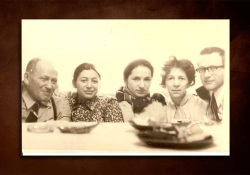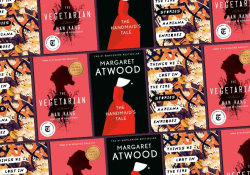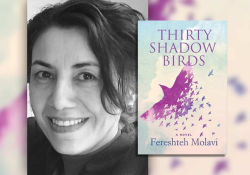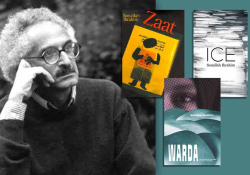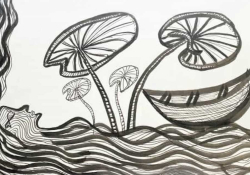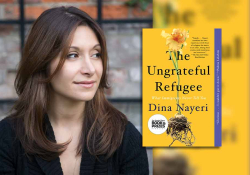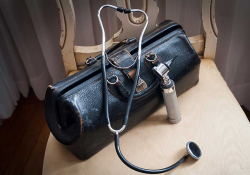Hiding the Body: My Susan Sontag Story

Like a dead pop star, Susan Sontag left behind a lot of fans who claim they knew her. After the release last September of Benjamin Moser’s new biography, Susan Sontag: Her Life and Work, they were all over the internet, sharing stories. Writers, of course. Especially queer writers. Does every queer writer who lived in New York City and published a book sometime between 1960 and 2000 have a Sontag story?
I do! Here’s mine:
Eighteen years ago, shortly after she won the National Book Award for her fourth novel, In America, some of which she had been accused of plagiarizing, and a few months before she published, in the New Yorker, maybe the only response to the 9/11 attacks, in their immediate aftermath, that was worth considering, she was invited, along with John Updike and Norman Mailer, to read at Queens College CUNY, where I teach creative writing. Surely the most impressive trio of literary bigwigs of a certain era ever to read together in Flushing.
Three idols. I had long regarded their work with awe and envy. In my early twenties, in the 1980s, in a studio apartment on the Upper West Side of Manhattan, hot and airless in summer, frigid in winter, I read—eagerly, jealously—everything they wrote. I was an aspiring writer, and they were my workshop instructors and problematic literary parents. Updike’s Couples taught me how to do a party scene. Mailer’s An American Dream was where I learned about “voice.” Yes, argh and alas, those men were sexists. I clocked their flaws. And Sontag, who wrote shiny, glamorous sentences, anchored in certainty, was frustratingly, to me, a closeted lesbian (okay, bisexual) playing both sides of the homo/hetero divide: in “Notes on Camp,” she was gay for pay, the fearless, presumptive heterosexual doing a deep dive into gay (male) culture to bring back up to the straight world, and the Partisan Review, nuggets of irony, and permission to like, if only in quotes, Swan Lake.
Sontag! I had image envy. Her portrait on the cover of her story collection I, etcetera! Black-and-white Thomas Victor photo. Paperback edition. She’s leaning, framed in a window, high above Central Park, in Frye boots, sweater, and slacks, her left arm on a stack of manuscripts, her right leg bent at the knee and planted on the windowsill, her left leg dangling. Tensile and lounging at the same time, in Mayor Abe Beame’s late 1970s defaulted New York City, with the shadow of her upraised knee—a duplicate of a duplicate!—cast on the glass, and her face-of-an-existentialist-hero bright and ovoid and framed by thick black hair.
She said she was not interested in being famous, iconic. Really? I read her essays, all of them, repeatedly. I read her fiction, even her first novel, The Benefactor, which was like eating a horse blanket. On Photography, Illness as Metaphor, over and over. Inscribing argumentative marginal notes in my copy of Against Interpretation was all I did in 1983. She was, like Mailer, and less so, Updike, one in a small pantheon of then-living writers—mostly the circle of New York Jewish intellectuals down to the second and third generation—whom I hoped would be first responders to my first novel. Especially Sontag, because it was an AIDS novel, and I was queer like her, writing about illness stripped of metaphor. “What will Susan think of this?” I wondered, as I wrote. My hubris! My heart-shattering expectation. Oh, well. I never found out.
So I was hopeful and anxious to see Sontag, Mailer, and Updike in real time in the actual world, even so late in their careers: Sontag died in 2004, Mailer in 2007, Updike in 2009. There was the sense of greeting giants in the moment before their passage to literary immortality. And there would be dinner afterward! To which I was invited.
Except, oops. Never meet your idols? Because: have there ever been three writers with less a sense of audience, anyway in front of an audience, than John Updike, Norman Mailer, and Susan Sontag?
Updike read first, “a story of New York,” he said, in which a young white married couple gets through a bad patch thanks to the intervention of a magical “Negro.” He never gets a name. Just “the Negro.” And I had brought my students to hear this. We had been discussing, that afternoon, Toni Morrison’s Playing in the Dark, where Morrison says black characters appear in white fiction only in order to help white characters learn something necessary and profound.
I was cringing. Mailer was next. He was walking with two canes, on which he climbed onstage, headed for the back wall, turned, and came slowly down to us on four legs. At the podium, he slowly unwrapped a white cotton bandage that had been spun around his neck and part of his head. When his big head was free, he smiled and said, “I know a lot about pharaohs.” And then he read a passage from his “Egyptian” novel, Ancient Evenings, that was so mired in Orientalism that not even Edward Said could have done it justice.
Did I mention that Queens College is in Queens? The most ethnically, racially, linguistically diverse county in America?
Sontag was last, and to her credit she was offensive mostly because she was dull. She read a long passage from her prizewinning historical novel In America, which was Samuel Beckett crossed with a Wikipedia entry.
Of course, I made sure I sat next to her at dinner.
Oh, I know I’m duplicitous. I know she wasn’t my friend. Still, she was famous for inviting new writers, especially gay men, on lunch dates that included a stop at a bookstore, where she insisted they accept the gift of a book, hand-picked by her. I wanted to be her pet gay, given books! I wanted her to read mine, even still. Here’s how I told her: I squeezed in beside her at the long table in an Italian restaurant in Long Island City and said, “Ms. Sontag, do you do a lot of research when you’re writing a historical novel?”
If I could turn back time. Of course she thought I was asking about plagiarism. She had an unexpectedly shy but direct gaze, and she turned to me sharply, there was to be no mistaking her intention, and said: “Of course I do research. Why would you ask such a question?” “Well,” I said, “I’m not sure my fiction students do research.” And she said, “Are you comparing me to your students? I’m not a student. I’m a literary artist.” And she spun away and left me staring hot faced across the table at Norman Mailer, who apparently would talk to anyone.
She was not my queer buddy. Not that she ever would be, or should be. She owed me nothing. Anyway, was she queer, would she have called herself queer? And who cares? The death of a great artist, or intellectual, or actor, or pop star, or internationally renowned literary figure, who is any part of the designation LGBT, but refuses that identification: What can you say about a queer like that? How does a biographer write about an LGBT person who never said they were? No matter their private thoughts or public actions or intimate commitments or hedged admissions or huffy denials?
And what about LGBT people who want to name, to list, their queer idols? Brag, pay homage, honor them? Or rebuke them: Roy Cohn was gay, but who wants him? Anyway, what does your sexuality have to do with your writing about metaphors? And what happens when straight people write about gay people writing about closeted queers?
Here’s Janet Malcolm, preeminent critic of the art of biography, also its esteemed practitioner, in the September 23 New Yorker, seemingly bashing back at Moser for having, in his Sontag book, an agenda—a gay agenda? Moser, unlike Malcolm, is not an artist, not a crafter of gorgeous sentences perfectly balanced in paragraphs that are themselves miniature essays. But he is, unlike Malcolm, not just gay, but invested, politically and personally, as writer and biographer, in the recent history of queer politics, particularly around the issues of closetedness and AIDS.
“Moser’s exasperation with Sontag is fuelled by something that lies outside the problematic of biographical writing,” Malcolm writes, setting us up to judge—dismiss?—an angry queer who is about to burst into flame: fuel supplied, match lit, flamer rising. It’s unclear to me that Moser finds Sontag any more or less exasperating than anyone else does, or did (“I loved Susan, but I didn’t like her,” Malcolm quotes Moser quoting Leon Wieseltier), but what is the “something” so disruptive to biography that it must be taken outside and detonated in the yard?
What is the “something” so disruptive to biography that it must be taken outside and detonated in the yard?
First offense: in talking about Sontag’s closetedness, Moser, says Malcolm, “drops the mask of neutral observer.” Is she speaking censoriously? Surely not. No biographer has been more incisive and interesting than Malcolm about the necessary and distorting use of authorial masks—the screens that slide back and forth across the visage of a biographer who is committed to revealing truth, even if only the impossibility of knowing, or telling, the truth.
Criticizing Sontag, Moser drops the mask, Malcolm says (accuses?), and “suddenly swerves to the side of the [openly lesbian] poet Adrienne Rich,” whom Moser “holds up . . . as ‘an intellectual of the first rank’ who had ‘written essays in no way inferior to Sontag’s’ and as an exemplar of what Sontag might have been if she had had the guts”—that is, if Sontag had been openly gay.
Moser “swerves to the side” of Rich. Necessary to take a bent path to reach a queer? Do lesbians need gay men to lift them up to the light? So they can be seen? Is that what Moser is doing? “At a time when homosexuality was still being criminalized, Rich had acknowledged her lesbianism, while Sontag was silent about hers,” Malcolm allows, granting Moser his facts, while pointing to the source of what she might call his petulance. What bugs Moser, Malcolm says (objects?), is this: “Rich had been punished for her bravery (‘by coming out publicly, [she] bought herself a ticket to Siberia—or at least away from the patriarchal world of New York culture’), while Sontag had been rewarded for her cowardice.”
If Malcom disagrees with Moser’s assertion that Sontag was rewarded for staying in the closet and Rich was punished, if she thinks he’s wrong, she doesn’t say. I’m not calling her a homophobe. Whether or not she agrees with him is not her concern. What he does wrong, as a biographer, she suggests, is to get mad. At Sontag. To take it personally. To be peeved, in print, that she never came out. Silly narcissist, does he think the book is about him?
Here is what he also does wrong, according to Malcolm: “[He] can barely contain his rage at Sontag for not coming out during the AIDS crisis. ‘There was much she could have done, and gay activists implored her to do the most basic, most courageous, most principled thing of all,’ he writes. ‘They asked her to say “I,” to say “my body”: to come out of the closet.’ Moser cannot forgive her for her refusal to do so.”
So it’s AIDS that lies outside the problematic of biography. Global AIDS, government neglect of AIDS, the AIDS deaths of 14,500 Americans and counting by the time Sontag published AIDS and Its Metaphors in 1989. A year earlier, the known US death toll had been 4,855. By the end of the 1980s AIDS was the leading cause of death in New York City for men between the ages of twenty-five and forty-four, and black women between the ages of fifteen and forty-four.
People are dying. What are you doing?
An ACT UP chant. ACT UP New York formed in 1987, two years before Sontag published AIDS and Its Metaphors and a year after the New Yorker ran her story “The Way We Live Now,” which is evidently about an artist and intellectual dying of AIDS and his arty, egg-heady friends—twenty-six of them, one for each letter of the alphabet, Aileen to Zack, and including a Quentin, an Ursula, and a Wesley—but which Sontag later said was not about AIDS. “She wanted it to be bigger than that,” said Howard Hodgkin, the British artist who collaborated with Sontag on a boutique illustrated edition of the story, published in 1991 to raise money for AIDS charities in England and the US.
“The Way We Live Now” is a dazzling structural feat, disciplined, acute, observant, a polyphonic story that orchestrates twenty-six voices, weaving them into a chorus, everybody’s autobiography, people coming together and apart in brief encounters, gossiping and grieving in phone calls and coffee shops, the way busy Manhattanites manage connection: voices spun around the body of what is not yet a corpse, a man lying in a hospital bed, though sometimes ambulatory, sometimes at home, working, writing, evidently dying, though not of AIDS. The word is never mentioned.
It’s beautifully done. Makes its own aesthetic rules, sticks to them. Tonally daring. Innovative. Also morally vacant. Did I say that? Sure, why not? AIDS as narrative device, nothing more. A creative writing exercise: Hemingway’s “Hills Like White Elephants” except the unspeakable isn’t “abortion” but “AIDS.” “Know the most important thing, and leave it out,” Hemingway says. When I read “The Way We Live Now” in the New Yorker in November of 1986, I was enraged. The body was missing. The evidence of loss. Habeas corpus? Show us the body, bring the body? “The Way We Live Now” does the opposite. It hides the body, swaddles it in the chatter of narcissists, some straight, some gay, whose lives are circumscribed by what is unmentionable, the queer body, ravaged by AIDS.
She’s right, in a way, that the story is not about AIDS. It seems to be about her. Max, the dying homosexual, has “begun keeping a diary for the first time in his life, because he wanted to record the course of his mental reactions to this astonishing turn of events.” AIDS as an “astonishing turn of events”? Really? Half the guests at my twenty-fifth birthday party, 1984, were dead in two years, and I don’t think any of them would have called it “an astonishing turn of events.” Maybe Sontag, a cancer survivor, is channeling her own survival tactics? “To live better, more deeply, more in touch with his work and his friends, and not to care so passionately about what people thought of him”: these are Max’s resolves in the face of epidemic death, but they sound like Sontag’s diary entries, which we can read now, published in two volumes and authorized by her son.
I don’t mean to erase her illness and her surprising, almost mythic recovery from stage-four breast cancer, which, by 1975, had spread throughout her body. She had been given a 10 percent chance of still being alive in two years. Miraculous recovery. Is “The Way We Live Now” her personal trauma narrative? It’s not very personal. And it’s full of details specific to AIDS. There was no way not to read it, in November 1986, a year after public awareness of AIDS had been increased by Rock Hudson’s death, as anything but a story of a group of friends reacting to the impending AIDS death of a central figure in their group.
Moser likes “The Way We Live Now” way more than I do. His problem is not with the story but with Sontag saying that it was “bigger than” AIDS, that it was meant to resonate beyond AIDS, to be an abstract meditation on our—whoever “our” includes—inability to think about illness directly, but only circumambiently, metaphorically.
Yeah, maybe. What about the coy elision of AIDS from a story about a man dying of AIDS? I’m not sure people under age fifty, and including millions of straight people who were legal adults in the 1980s and ’90s, get how isolating, alienating, infuriating it was to feel that AIDS was illegible to most Americans. Not even scary, but scratched off the page. A blank in the text. Therefore unmentionable. Unmentioned at AIDS funerals I attended throughout the 1980s. Unmentioned by President Reagan, who did not say even the word “AIDS” in public until September 1985, eight months into his second term, two months before Rock Hudson died, a year before Sontag left AIDS out of “The Way We Live Now.”
I’m not sure people under age fifty, and including millions of straight people who were legal adults in the 1980s and ’90s, get how isolating, alienating, infuriating it was to feel that AIDS was illegible to most Americans.
I don’t think AIDS interested her, personally, politically, though she showed up at the deathbeds of friends, including the artist Paul Thek, who died of AIDS in 1988, and to whom both Against Interpretation and AIDS and Its Metaphors are dedicated. AIDS and Its Metaphors is a curiously dry performance, hardly an intervention against political and medical neglect of AIDS, though saving lives is not its point. People were dying, and what was she doing? Susan Sarandon showed up at an ACT UP meeting. Susan Sontag, public intellectual, former Girl Scout, she liked to say, burdened with a moral conscience and a Girl Scout’s spirit of do-goodism; later defender of Salman Rushdie against fatwa; later intrepid missionary to the war zone of Sarajevo; a moralist in the Emersonian mode, metaphysician of the pain of others: she wrote a couple of rather abstract things about AIDS, one of which she denied had anything to do with AIDS, and left it at that.
What bugged and bugs me most about “The Way We Live Now,” and what Malcolm perhaps thinks is meant to remain outside the circle enclosing the appropriate substance of biography, is not that its writer was closeted, or rather, not that she preferred to remain closeted, even maybe to herself, but that the literary community that befriended and published and promoted her wanted her straight: intrepid heterosexual, who speaks hip, and knows queers, wanders into the youth culture and the faggy downtown, all for your literary and cultural edification.
Let’s talk about the reflexive, nay, compulsory homophobia of the intellectual left in America in the 1950s and ’60s—the lefty editors, writers, critics, poets, novelists, and thinkers who were in or orbited the circle of New York intellectuals, whom Moser calls “The Family,” and who were at the center of American intellectual life for half the twentieth century, from FDR to Ronald Reagan. Who befriended and published and promoted Sontag.
In 1950 Mary McCarthy published, in the New York Post, a series of leisure pieces under the heading “Greenwich Village by Night,” which included her impressions of Village homosexuals: “A blue-eyed, marcelled white fag behind us suddenly begins to camp excruciatingly,” etc. In 1955 Norman Mailer allowed himself to be published in the Mattachine Society’s gay liberation magazine One, for whom he wrote “The Homosexual Villain,” a brave display of tolerance: “I found myself thinking,” he wrote, “My God, homosexuals are people too.” Of course, he ends by saying homosexuals had better stop acting so superior to straight people, because “heterosexuals are people too.”
Oh, there are so many examples of both casual and aggressive homophobia in novels and essays and poems and plays of the 1950s and ’60s, by McCarthy, Mailer, Saul Bellow, Midge Decter, Norman Podhoretz, Philp Roth, John Updike, John Cheever, even James Baldwin and Gore Vidal, who were gay, but had learned, as Sontag did, to be cagey about it. McCarthy, whose second husband was bisexual, trashed Tennessee Williams because she thought Blanche du Bois was a fag’s icky fantasy of being a girl. The shock ending of her novel The Group is that its most blue-blooded, high-WASP character is a lesbian in love with a short, fat, cigar-chomping Hungarian butch. Robert Lowell’s poem “Skunk Hour,” dedicated to his lesbian friend Elizabeth Bishop, talks about “our fairy decorator” who ran an antique shop on the Maine coast. To quote Podhoretz’s and Decter’s 1960s antigay comments these days is almost a hate crime.
Moser quotes Edmund White saying that “in the pre-internet age,” “people would have been really shocked” to learn that Sontag was gay, “and her readership would have been reduced by two-thirds.” If she had been openly gay, her essays on subjects that were seen as signal aspects of gay culture—camp, pornography, aesthetics, even French film—would have been treated by straight people as biased, a form of special pleading by a queer person on behalf of queer art. “I am strongly drawn to Camp, and almost as strongly offended by it,” Sontag said, in the headnote to “Notes on Camp.” Heteronormative culture of the 1960s demanded a straight voice to write about queer stuff—to render, objectively, homosexuality’s charms and its offenses. If Sontag had been openly gay, she would have found herself in a double bind: she would not have been trusted to write about gay culture; and/but, she would not have found work writing about anything except gay culture. Straight publications would not have hired an open homosexual to write about serious, heterosexual concerns.
Sontag wanted a big career, so she didn’t come out. What would you have done? What did Baldwin and Vidal do? What would Janet Malcolm have done? Maybe this is a question to have asked Audre Lorde, who was almost exactly one year younger than Sontag (Adrienne Rich was four years older) and who made her lesbianism a subject of her work from early on. “Let me tell you first about what it was like being a Black woman poet in the ’60s, from jump,” Lorde said. “It meant being invisible. It meant being really invisible. It meant being doubly invisible as a Black feminist woman and it meant being triply invisible as a Black lesbian and feminist.”
Was Sontag’s closetedness a career move? I can’t blame her. I was born in 1959, the year she moved to New York, and the atmosphere of my childhood and adolescence, in a commuter suburb of Manhattan, was intensely, violently homophobic. I get that she could not have been out and a central figure in the country’s intellectual life in 1965. Later an iconic figure. 1987, though, is a different story. What she did wrong, I’d say, was publish a story like “The Way We Live Now” in 1987 without identifying herself as queer—a move that made it seem that this was just another of Susan’s exemplary forays into the culture of the Other. Brave anthropologist, risking germs, maybe even risking infection (I will never forget the hospital orderly in 1985 who would not come into the room to retrieve the dinner tray from a friend of mine who lay dying in his bed) in order to bring back to the straight world reports from the margins of experience.
“The Way We Live Now” is a report from the edge of suffering delivered by an ostensible straight. Its cool tone—“a hot subject in a cold frame,” to quote Sontag—its abstract intelligence, its distancing itself from the real, visible, material symptoms of a body in the process of ingesting itself from the inside out, its WASPy punctiliousness, its presenting itself as neither personal nor political, but as a universal depiction of loss, its artistic remove from the terrible suffering it was ostensibly chronicling, suffering that was visible on any street on any day all over the city where Sontag lived, thirty-year-old dying women and men walking slowly down Manhattan streets supported by canes and wheelchairs and ex-lovers and best friends: its very style rendered it a gay story for straight people, and asked nothing of them, politically, perhaps even personally, in a moment when thousands of people around the world were dying terrible deaths.
The very style of “The Way We Live Now” rendered it a gay story for straight people, and asked nothing of them, politically, perhaps even personally, in a moment when thousands of people around the world were dying terrible deaths.
It was a cowardly performance, made even more galling by its reception as one of the first brave fictional depictions of AIDS. It is still treated as a landmark in the literature of AIDS. For instance, a September 2017 post on Electric Literature, naming ten of the most notable early texts on AIDS, lists “The Way We Live Now” second after Samuel Delaney’s 1985 Flight From Nevèrÿon. (Full disclosure: my novel The Irreversible Decline of Eddie Socket is listed third, jointly with my friend David B. Feinberg’s Eighty-Sixed, both published in 1989. Feinberg died of AIDS in 1994. Am I just being competitive and jealous? Ask Malcolm!)
I would argue that Sontag, throughout the period of her greatest cultural influence, as thinker and writer, was read in straight culture as heterosexual, and that’s what she wanted, what she encouraged. (One rumor among queers was that she would not come out as gay as long as there was still a chance she could win the Nobel Prize.)
Heterosexuals claimed Sontag for themselves, their adventurous sister, who is maybe just a little bit—a tiny bit—gay, because gay rubs off on you, and she did seem to know an awful lot about the gays, or anyway, gay men, though she was clear to say she found their culture at least as offensive as she found it interesting: no one, including an intellectual of conscience, could like gays uncritically, without judgment, without censure. Approach/avoidance was as near as you dared to get.
That’s the tone in which straight people, perhaps even some gay people, read Sontag, the tone she established at the beginning of her career, 1964, when she wrote “Notes on Camp,” and which she maintained throughout her career, even when she published “The Way We Live Now” in the midst of the global AIDS crisis.
Is a refusal to act, to identify yourself with a suffering minority, when the moral imperative to act, to so identify, is everywhere apparent—is that outside the range of the biographical project or problematic?
Sontag taught me to be skeptical and specific. “The Way We Live Now” is a shameful feint.
Her closetedness helped straight people maintain their distance from AIDS.
Her sentences were glamorous, yes. I said that. They were clear water moving downstream; you could see to the bottom where the rocks were. She caressed structure. Her careful, perceptive, sensual outlining of the narrative and filmic and argumentative strategies of Jean-Luc Godard’s Vivre sa vie is a lesson in the erotics of art as necessary literary heuristic, as she says in “Against Interpretation”: to show how a film or novel or essay works, how it generates meaning, rather than to say what it means.
Malcolm is a more supple thinker. Her inability, refusal, reluctance to think through the implications of Sontag’s closetedness is all the more surprising because of her wonderful book about Gertrude Stein and Alice B. Toklas, in which she is able to see, understand, convey the complexities, often unflattering, even condemning, of two queer women living, staying alive, in Vichy France during World War II.
Sontag and Malcolm are both writers who have helped outline for me the obligations of a writer who means to tell the truth. They are the same age. Sontag is one year older. Malcolm has not had to live through the lacerating self-loathing that Sontag, as a lesbian, survived for decades, and which so many women and men her age were made to survive. Certainly both Malcolm and Sontag established careers as renowned writers and intellectuals during decades when intellectual men, writers, editors, would have made them invisible.
I am grateful to them both.
Does it matter, though, to our reading of her work, our reading of her life, her private and public actions, her literary output, her artistic and intellectual standing, her public image, that Sontag—unlike Audre Lorde, unlike Adrienne Rich—never came out?
I think it matters. And not just to me.
Brooklyn, New York


